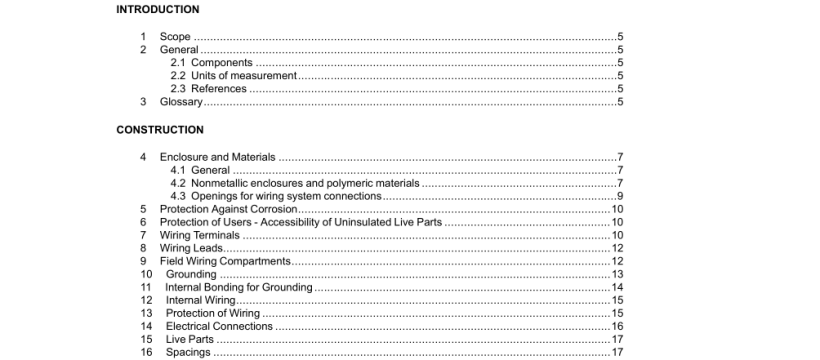UL 3730-2021 pdf download.Photovoltaic Junction Boxes.
3.3 BARRIER – A part inside an enclosure that reduces access to a part that involves a risk of fire, electric shock, injury to persons, or electrical energy-high current levels. 3.4 ELECTRIC SHOCK – VOLTAGE – A live part does not involve a risk of electric shock when the maximum voltage of the part to ground does not exceed 30 Vdc. 3.5 ENCLOSURE – A surrounding case constructed to provide a degree of protection against: a) The accessibility of a part that potentially involves a risk of fire, electric shock or injury to persons, or b) The risk of propagation of flame, sparks, and molten metal initiated by an electrical disturbance occurring within. 3.6 FIELD-WIRING LEAD – A lead to which a supply, load, or other wire is intended to be connected by an installer. 3.7 FIELD-WIRING TERMINAL – A terminal to which a supply, load, or other wire is intended to be connected by an installer. 3.8 FIXED UNIT – A unit that is intended to be permanently connected mechanically and electrically and only able to be detached by the use of a tool. 3.9 GROUNDED CONDUCTOR – A system or circuit conductor that is intentionally grounded. 3.10 KNOCKOUT – A portion of the wall of an enclosure so fashioned that it is capable of being readily removed by a hammer, screwdriver, and pliers at the time of installation in order to provide an opening or hole for the attachment of an auxiliary device, raceway, cable, or fitting. 3.11 LIVE PART – An electrically conductive part within a unit that during intended use has a potential difference with respect to earth ground.
3.12 MAXIMUM SYSTEM VOLTAGE – The sum of the open-circuit voltage (Voc) of the photovoltaic module or panel multiplied by the temperature correction factor specified in Article 690.7 of the National Electrical Code, ANSI/NFPA 70, for the maximum number of crystalline and multi-crystalline silicon photovoltaic modules and panels in a series string. The maximum system voltage is equal to the sum of the Voc for the maximum number of amorphous silicon and thin film photovoltaic modules and panels in a series string. 3.13 OPEN-CIRCUIT VOLTAGE (Voc) – The maximum no load output voltage of a photovoltaic module or panel at standard test conditions (STC). 3.14 PERMANENTLY CONNECTED UNIT – A unit connected to the electrical supply by means other than a supply cord and an attachment plug. 3.15 PRESSURE TERMINAL CONNECTOR – A terminal that accomplishes the connection of one or more conductors by means of pressure without the use of solder. Examples of pressure terminal connectors are: a) Barrel and setscrew type, b) Crimp-type barrel, or c) Clamping plate and screw type.
4 Enclosure and Materials 4.1 General 4.1.1 Photovoltaic junction boxes shall be considered an enclosure or be provided with an enclosure that houses all current-carrying parts. The enclosure shall protect the various parts of the unit against mechanical damage from forces external to the unit. The parts of the enclosure that are required to be in place to comply with the requirements to reduce the risk of fire, electric shock, injury to persons shall comply with the applicable enclosure requirements specified in this standard. 4.1.2 The frame or chassis of a junction box shall not be relied upon to carry current during normal operation. 4.1.3 A part, such as a nameplate that is a part of the enclosure shall comply with the enclosure requirements. 4.1.4 Sheet-metal screws threading directly into metal shall not be used to attach a cover, door, or other part that is to be removed to install field wiring or for operation of the equipment. Machine screws, self- tapping machine screws, and thread forming screws are able to thread directly into sheet-metal when they allow for at least two full threads of screw engagement. 4.1.5 Sheet-metal screws mounting internal components that are not removed for installation or operation are able to thread directly into metal.UL 3730-2021pdf download.
UL 3730-2021 pdf download
